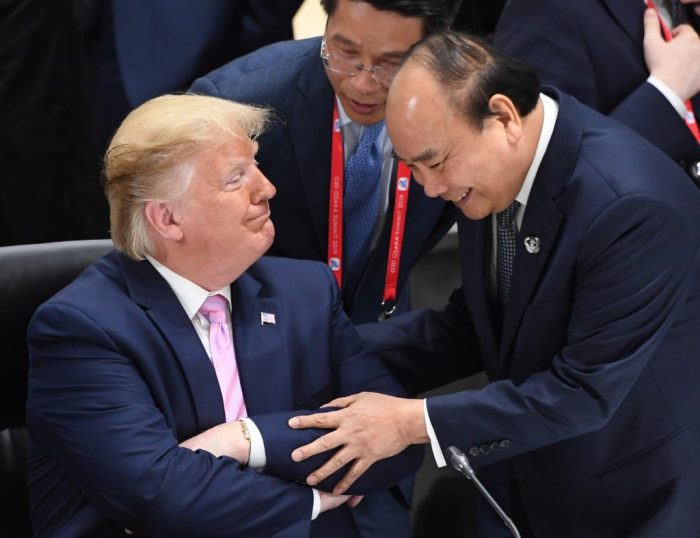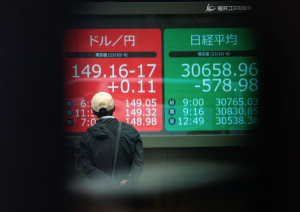(ATF) Amid improved bilateral relations and a fledgling friendship between former adversaries the US and Vietnam, a stubborn wrinkle has yet to be ironed out – one that could cause major complications as the two sides agree and forge ahead in cooperation on a number of other issues.
On late Friday, the Trump administration announced that it’s launching an inquiry into Vietnam’s trade practices, including what the US Trade Office called “acts, policies, and practices that may contribute to the undervaluation of its currency and the resultant harm to US Commerce.”
Washington is invoking the same trade law, Section 301 of the Trade Act of 1974, that it’s used in its two-and-a-half year protracted trade battle with Beijing to level hefty tariffs on Chinese imports.
“Unfair currency practices can harm US workers and businesses that compete with Vietnamese products that may be artificially lower-priced because of currency undervaluation,” US Trade Representative Robert Lighthizer said in a statement.
“We will carefully review the results of the investigation and determine what, if any, actions it may be appropriate to take.”
The US Treasury has three criteria used for determining whether a country can be labelled a currency manipulator, including a trading partner with a significant trade surplus of at least US$20 billion over a 12-month period, a sizable current account surplus of at least 2% of GDP over a 12-month period, and evidence of repeatedly conducting net purchases of foreign currency in at least six out of 12 months, with these net purchases totalling at least 2% of its GDP over a 12-month period.
This isn’t the first time that Washington has expressed concern over Vietnam’s currency practices. In January, the US placed 10 of its trading partners on a so-called “current manipulation watchlist,” including Vietnam, China, Japan, South Korea, Germany, Italy, Ireland, Singapore, Malaysia and Switzerland.
At the time, it urged Vietnam to “reduce its intervention and allow for movements in the exchange rate that reflect economic fundamentals, including gradual appreciation of the real effective exchange rate.” The US also placed Vietnam on its currency manipulation watchlist in May 2019.
Vietnam, not surprisingly, continues to deny that it undervalues its currency to gain unfair trade advantages.
A few days before the US announcement, Vietnam’s State Bank Governor Le Minh Hung said the country has never used monetary policy to give his country an unfair trade advantage, the same response given on several previous occasions.
He added that Vietnam will continue pursuing monetary policies to create macro stability, sustainable growth and support measures to help with the nation’s economic recovery.
Double-edged sword
For Vietnam, its improved relations with the US has become a double-edged sword. As US companies continue to pivot their manufacturing and supply chains away from China amid the Sino-American trade war, and relocate across the region, Vietnam has thus far benefited the most.
As such, Vietnam has now morphed to become one of the US’ top ten trading partners.
However, Vietnam’s gain has also bloated an already large trade deficit with the US, all coming at at a time that President Trump has taken a hard line on both friend and foe alike over what he considers systematic and unfair trade practices. Trump said in a 2019 interview that Vietnam was “almost the single worse abuser of everybody,” prompting concerns from investors that Vietnam’s favorable relationship with the US was in jeopardy.
For the January to July period, Vietnam’s trade deficit with the US increased to $46.4 billion, a 10.8% increase from the same period last year, according to US Census Bureau data. However, just as problematic, US exports to Vietnam decreased at a 1.8% rate from January through July compared with the same period last year. The US trade deficit with Vietnam is now nearly $40 billion, twice the amount stipulated in the US Treasury’s criteria.
Can geopolitics offset currency/trade woes?
However, at the end of the day, it remains to be seen if Washington, even under trade hawk President Trump, would be willing to alienate Vietnam over trade and currency manipulation problems.
The US-Vietnam bilateral mix includes not only trade issues but geopolitical gamesmanship at its finest, notably its growing strategic alliance against Chinese hegemony in the Asia-Pacific region and more precisely, its collective strategic moves against Beijing’s South China Sea overtures. This includes Beijing’s overlapping claims with Vietnam’s UN-mandated 200-nautical mile exclusive economic zone (EEZ), an area rich in fishing and hydrocarbon resources, particularly natural gas.
After a landmark trip to Vietnam in 2016, then President Barack Obama approved the sale of offensive military weapons and hardware to the country, an unprecedented move considering the history of armed conflict between the two sides as well as diametrically opposing political ideologies.
Improved relations has also led to US naval vessels making port calls to the country in the last few years, including a five-day visit by the super carrier USS Theodore Roosevelt to the port of Danang in March.
In 2018, Vietnam participated for the first time in the Rim of the Pacific (RIMPAC) – a maritime military exercise hosted biennially by the US military. Moreover, the US has also handed over a former coast guard cutter to Vietnam to help the country beef up its push-back against Chinese incursion into its territorial waters. It is also set to handover another cutter sometime this year.
Alexander Vuving, an expert on Asia security at the US Defense Department Institute said recently that “Vietnam holds a key to the regional balance of power.”
Vietnam is also the strongest voice among the 10-member Association of Southeast Asian Nations (ASEAN) against Chinese hegemony in the region.
In essence, the US needs Vietnam as much as the country needs the US, both geopolitically and in trade. It’s a delicate give and take as the two sides hammer out a new relationship in thus far uncharted waters.
























